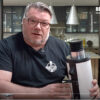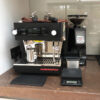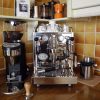One way valve bags or containers are something I believe in for the storage of roasted coffee and was interested to read the following on the internet.
Isn’t CO2 heavier than O2? So that would mean the CO2 would be lower in the jar than the O2 and as the CO2 is produced it would push the O2 out (assuming that the degassing valve is at a higher location.) I dunno, maybe I am wrong, but this seems right to me…
I couldn’t help thinking about this, as “Graham’s Law” applies here: The relative diffusion of a gas within a gas is inversely proportional to the square root of its molecular weight. Simply put, lighter molecules travel faster, have more frequent collisions and thus diffuse more rapidly? CO2 is heavier than air or Oxygen and will diffuse more slowly. In this case we are introducing CO2 into the sealed one way valve container. However this introduction of CO2 is done relatively slowly, too slowly for diffusion not to rear its head and mix the gasses. Even if you want to consider the diffusion is happening very slowly, it’s happening much faster than the rate at which CO2 is being formed.
BUT…it set me thinking about why having a one way valve works well and what we can do to maximise its beneficial effect. Now this is all theory, but the end result does seem to be far better when a one way valve is used. I can’t think of a better explanation and would be interested in comments to improve this article.
Quite a lot of CO2 is actually formed, and certainly will puff up a valve bag considerably. If we conduct a small armchair experiment…
Assume a 250g coffee jar with a 1 way valve has a free air volume of approximately 60 cc (it’s filled almost to the top with roasted coffee) and judging from the 100s of 250g coffee bags I have sealed, the volume of CO2 produced is at least 40cc . These values are chosen to make the calculations a little easier.
The next big if….all the degassing by the coffee is assumed to be CO2 (I don’t think it’s anything else)
1% of the air we breathe is made up of other gases and 99% is made up of Oxygen (21%) and Nitrogen (78%). So the 60cc in the valve jar is about 12cc Oxygen and 48cc Nitrogen….we then add 40cc of CO2. Our gas mix is now an evenly diffused
- 40% CO2
- 48%N
- 12% Oxygen
Of course if we had no one way valve at this point, although the % of Oxygen is lower, it’s partial pressure is higher and the effect on Oxidation will be unchanged (in fact the pressure might even help the oxidation reaction happen slightly faster). So having a sealed container, doesn’t help very much against staling, apart from not allowing fresh Oxygen in from the Atmosphere.
BUT…we have a 1 way valve….so what happens:
The excess (fully mixed gasses) pass out of the container through the one way valve (which equalises the pressure and we end up with 60cc left in the container, or 24cc CO2, 29cc N and 7cc O2:
- 40% CO2
- 48% N
- 12% Oxygen (but now of course at a lower partial pressure, so less of it to react with the coffee)
Now I have made some approximations and also used 60 and 40cc to make the numbers a little easier. But in general it’s reasonably safe to say that the concentration of Oxygen will drop considerably. This seems to be enough to slow down staling considerably, because of course as the Oxygen is used up in oxidation reactions (staling), the % of it will drop still further.
Now it’s not the exact numbers that matter here…it’s the general principle. Placing freshly roasted coffee in a jar is better than leaving it open to the atmosphere (not the very big difference you might think to leaving the lid off, because the 12cc of oxygen already in the jar is probably enough). Certainly though much better than an unsealed jar, but no better than a average fitting lid. The one way valve bag or jar, do seem to carry significant advantages here, mainly because of the “real” drop in available oxygen for oxidation processes.
This is definitely borne out by the difference in the smell of coffee stored in one way valve bags and the definite difference in extraction and flavour of those coffees. Someone did mention a pinhole being possibly quite effective and I would agree a pinhole would be better than say a “sealed container with no valve”. Also important is to not start out with too much air space, as the potential drop in O2 able to react with the coffee is that much smaller.
I also intend to actually try out Pinholes to see if they will work almost as well as a one way bag…..I haven’t checked the science with diffusion across a pinhole, but I think I can safely assume that it will be very low. e.g. human in a large airproof box with a pinhole….soon dies 😆
To summarise:
- Storing roasted Coffee in 1 way valve containers (bags, jars tins), is probably optimum to minimise staling
- These containers should have as little headspace as possible (space not occupied by coffee beans)
- Once the seal is broken (assuming the coffee is no longer degassing), then the advantage of the 1 way valve is nullified
- If you can suck/remove some air from the container with a 1 way valve, then you reduce the amount of Oxygen and increase the effectiveness of the container.
- try and gently squeeze as much air out of the 1 way valve bag as you can after sealing.
- Sealed containers with no one way valve are probably worse than ones with a lid that is slightly loose and allows excess pressure to escape







Recent Comments